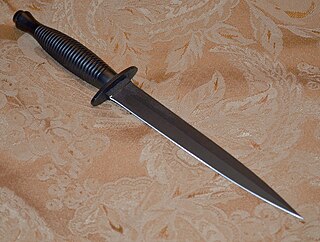
A dagger is a fighting knife with a very sharp point and usually one or two sharp edges, typically designed or capable of being used as a cutting or thrusting weapon. Daggers have been used throughout human history for close combat confrontations, and many cultures have used adorned daggers in ritual and ceremonial contexts. The distinctive shape and historic usage of the dagger have made it iconic and symbolic. A dagger in the modern sense is a weapon designed for close-proximity combat or self-defense; due to its use in historic weapon assemblages, it has associations with assassination and murders. Double-edged knives, however, play different sorts of roles in different social contexts.
A sword is an edged, bladed weapon intended for manual cutting or thrusting. Its blade, longer than a knife or dagger, is attached to a hilt and can be straight or curved. A thrusting sword tends to have a straighter blade with a pointed tip. A slashing sword is more likely to be curved and to have a sharpened cutting edge on one or both sides of the blade. Many swords are designed for both thrusting and slashing. The precise definition of a sword varies by historical epoch and geographic region.
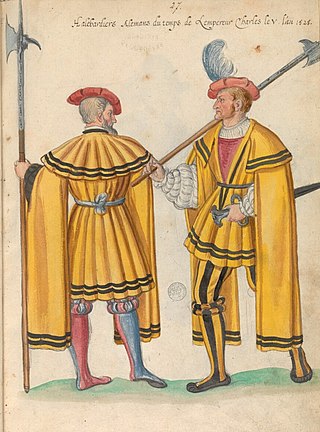
A halberd is a two-handed polearm that came to prominent use from the 13th to 16th centuries. The halberd consists of an axe blade topped with a spike mounted on a long shaft. It can have a hook or thorn on the back side of the axe blade for grappling mounted combatants. The halberd was usually 1.5 to 1.8 metres long.

The Urnfield culture was a late Bronze Age culture of Central Europe, often divided into several local cultures within a broader Urnfield tradition. The name comes from the custom of cremating the dead and placing their ashes in urns, which were then buried in fields. The first usage of the name occurred in publications over grave sites in southern Germany in the late 19th century. Over much of Europe, the Urnfield culture followed the Tumulus culture and was succeeded by the Hallstatt culture. Some linguists and archaeologists have associated this culture with a pre-Celtic language or Proto-Celtic language family.
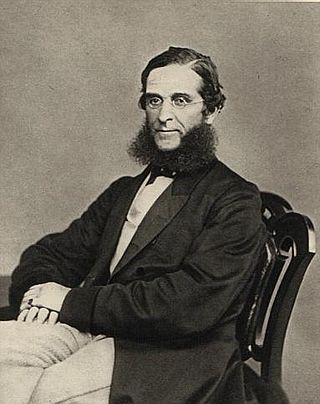
Sir John Evans was an English archaeologist and geologist.

The English language terminology used in the classification of swords is imprecise and has varied widely over time. There is no historical dictionary for the universal names, classification, or terminology of swords; a sword was simply a single-edged or double-edged knife.
A dirk is a long-bladed thrusting dagger. Historically, it gained its name from the Highland dirk where it was a personal weapon of officers engaged in naval hand-to-hand combat during the Age of Sail as well as the personal sidearm of Highlanders. It was also the traditional sidearm of the Highland Clansman and later used by the officers, pipers, and drummers of Scottish Highland regiments around 1725 to 1800 and by Japanese naval officers.

Bronze Age swords appeared from around the 17th century BC, in the Black Sea and Aegean regions, as a further development of the dagger. They were replaced by iron swords during the early part of the 1st millennium BC.
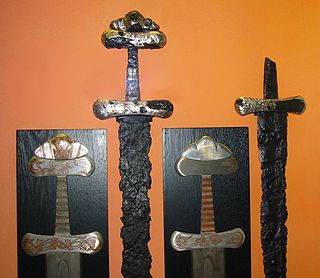
The Viking Age sword or Carolingian sword is the type of sword prevalent in Western and Northern Europe during the Early Middle Ages.
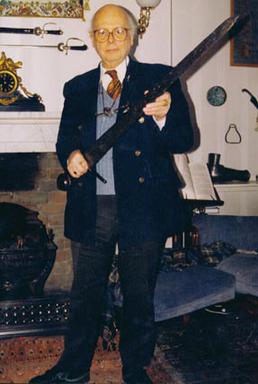
Ronald Ewart Oakeshott was a British illustrator, collector, and amateur historian who wrote prodigiously on medieval arms and armour. He was a Fellow of the Society of Antiquaries, a Founder Member of the Arms and Armour Society, and the Founder of the Oakeshott Institute. He created a classification system of the medieval sword, the Oakeshott typology, a systematic organization of medieval weaponry.

The Atlantic Bronze Age refers to a cultural complex of the Bronze Age period in prehistoric Europe, spanning approximately 1300–700 BC. This complex includes various cultures in Britain, France, Ireland, Portugal and Spain.
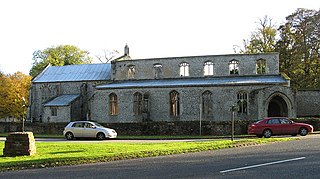
Oxborough is a village and civil parish in the English county of Norfolk, well known for its church and manor house Oxburgh Hall. It covers an area of 13.024 km2 (5.029 sq mi) and had a population of 240 in 106 households in the 2001 census, reducing to a population of 228 in 111 households at the 2011 Census. For the purposes of local government, it falls within the district of Breckland.

Carved stone balls are petrospheres dated from the late Neolithic, to possibly as late as the Iron Age, mainly found in Scotland, but also elsewhere in Britain and Ireland. They are usually round and rarely oval, and of fairly uniform size at around 2+3⁄4 inches or 7 cm across, with anything between 3 and 160 protruding knobs on the surface. They range from having no ornamentation to extensive and highly varied engraved patterns. A wide range of theories has been produced to explain their use or significance, with none gaining very wide acceptance.

Bronze Age Britain is an era of British history that spanned from c. 2500–2000 BC until c. 800 BC. Lasting for approximately 1,700 years, it was preceded by the era of Neolithic Britain and was in turn followed by the period of Iron Age Britain. Being categorised as the Bronze Age, it was marked by the use of copper and then bronze by the prehistoric Britons, who used such metals to fashion tools. Great Britain in the Bronze Age also saw the widespread adoption of agriculture.

A claymore is either the Scottish variant of the late medieval two-handed sword or the Scottish variant of the basket-hilted sword. The former is characterised as having a cross hilt of forward-sloping quillons with quatrefoil terminations and was in use from the 15th to 17th centuries.
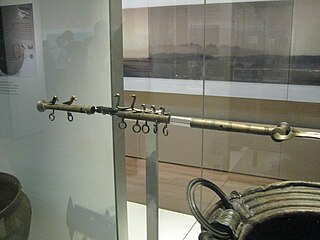
The Dunaverney Flesh-Hook is a sophisticated bronze artefact from Prehistoric Ireland, thought to be an item of ceremonial feasting gear, and a symbol of authority. It is believed it was used to remove chunks of meat from a stew in a large cauldron for serving. It dates to the Late Bronze Age, between 1050 and 900 BC. Since 1856, it has been in the British Museum in London.
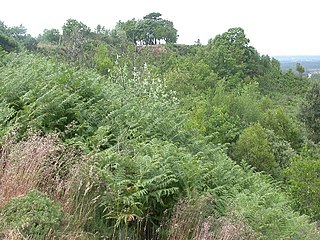
Caesar's Camp is an Iron Age hill fort straddling the border of the counties of Surrey and Hampshire in southern England. The fort straddles the borough of Waverley in Surrey and the borough of Rushmoor and the district of Hart, both in Hampshire. Caesar's Camp is a Scheduled Ancient Monument with a list entry identification number of 1007895. It lies approximately 3 kilometres (1.9 mi) north of the town of Farnham, and a similar distance west of Aldershot. The hillfort lies entirely within the Bourley and Long Valley Site of Special Scientific Interest. Caesar's Camp is a multivallate hillfort, a fort with multiple defensive rings, occupying an irregular promontory, with an entrance on the south side. The site has been much disturbed by military activity, especially at the southeast corner. The remains of the hillfort are considered to be of national importance.

Heathery Burn Cave is a cave near Stanhope, County Durham, England, in which a large collection of Late Bronze Age weapons and tools was discovered and excavated between 1859 and 1872.
There are two notable swords known recovered from the River Witham, both kept in the British Museum.
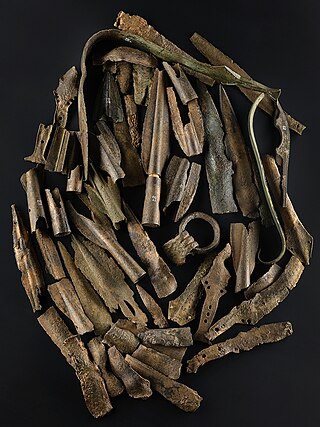
The Duddingston Loch Hoard, currently held by National Museums Scotland (NMS), comprises Late Bronze Age weapons and other objects which were found in Duddingston Loch in Edinburgh when workers were dredging for marl in 1778. The bronze objects were found along with human bones and animal horns.






















